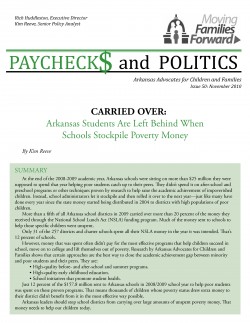
Arkansas schools routinely fail to spend millions of dollars meant to help their poorest students catch up to their peers, according to an analysis of education spending data by Arkansas Advocates for Children and Families.
Many school districts are rolling over poverty funds from year to year instead of investing in proven programs that help close the educational achievement gap between minority and poor children and their peers. At the end of the 2008-2009 academic year, schools were sitting on more than $25 million in unspent state-provided poverty money-called National School Lunch Act funds because the money is apportioned according to the number of students whose low family incomes make them eligible for free meals.
Only 31 of 257 Arkansas districts and charter schools-just 12 percent of schools-spent all their NSLA money in the year it was intended, according to the report “Carried Over,” the 50th issue of AACF’s Paychecks and Politics series.
Fifty four districts carried over more than 20 percent of their poverty money at the end of the 2008-2009 year.
“Not only are many schools sitting on this poverty money year after year, many aren’t spending the money in ways that will promote greater opportunities to learn and best close the educational achievement gap,” said Rich Huddleston, AACF executive director. “Children living in high-poverty areas are missing out on an early chance to catch up to their peers when schools stockpile money intended to help them.”
Research by AACF shows that certain approaches have the greatest potential to close the academic achievement gap between minority and poor students and their peers. They are:
- High-quality before- and after-school and summer programs.
- High-quality early childhood education.
- School initiatives that promote student health.
Just 12 percent of the $157.8 million sent to Arkansas schools in the 2008/2009 school year to help poor students was spent on these proven programs. That means thousands of children whose poverty status drew extra money to their district didn’t benefit from it in the most effective way possible.
The 2009 Arkansas General Assembly considered but didn’t pass Senate Bill 987, which would have restricted the amount of NSLA money and other “categorical” funds that schools could carry over. The bill proposed limiting it to 20 percent.
“NSLA funding has great potential for promoting greater opportunities to learn and should be increased when our economy rebounds. However, with each public penny tighter than ever, lawmakers in January should require school districts to spend these state funds the way the Legislature intended,” Huddleston said. “These kids can’t wait and our economy can’t wait. If students don’t graduate from school and succeed in college, then Arkansas will suffer.”
Huddleston also recommends that parents ask local school districts and school boards whether local poverty money is being spent on proven strategies with the most potential to close the achievement gap.
In addition, the report recommends that Arkansas require schools to demonstrate what impact the poverty money they spend has on helping low-income children improve their academic achievement.
